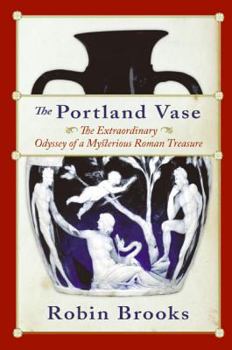The Portland Vase: The Extraordinary Odyssey of a Mysterious Roman Treasure
Select Format
Select Condition 
Book Overview
Created for an emperor, exhumed from a burial ground, coveted, traded, smashed, restored, and stuffed full of incident and intrigue, the Portland Vase -- the most famous of all Roman antiquities --... This description may be from another edition of this product.
Format:Paperback
Language:English
ISBN:0060511001
ISBN13:9780060511005
Release Date:August 2005
Publisher:Harper Perennial
Length:272 Pages
Weight:0.37 lbs.
Dimensions:0.7" x 5.3" x 8.1"
Customer Reviews
1 rating
The History of the Greatest Roman Glasswork
Published by Thriftbooks.com User , 20 years ago
Prospective buyers of the most expensive artworks are always told to examine the provenance of an object before buying. There are few works that can have the exclusive and eccentric list of owners as the Portland Vase has had. One of the most famous of ancient artworks, and now in the British Museum, it has fascinated historians, poets, mythologists, and potential owners ever since it came to light (probably by a grave robber in Rome) in 1582. In -The Portland Vase: The Extraordinary Odyssey of a Mysterious Roman Treasure_ (HarperCollins), Robin Brooks has given a biography of a unique object, not only telling its history and about the lives of those who owned and held it, but also about the centuries of unresolved argument about what the figures on the vase mean. It is an intriguing story that weaves through much of European history. The vase itself is a little object, something less than ten inches tall. It is not pottery, like most ancient vases, but blue glass, decorated with white figures of classical male and female nudes. The argument about who they are includes Jupiter and Venus among the most frequently sighted, with Orpheus and Eurydice, Pluto, Castor and Pollux, and a host of others (including, anachronistically, the physician Galen). Once the vase left the family of Pope Urban VIII (sold to pay gambling debts) it belonged eventually to the successive Dukes of Portland. The fourth duke leant it to the British Museum, where it was smashed by a confused visitor in 1845. The 200 pieces and smaller shards were gathered up, and painstakingly glued together by the best restorer in the land. The vase is timeless, but repairs are temporary; it has been dismantled and re-repaired in 1949 and again forty years later. The vase's story, told here with eagerness and amusement, is one full of surprises and brushes with famous admirers like Wedgwood, Keats, and Blake. There are three sections to the book, consisting of "The Lip" (the prologue), "The Body" (consisting of nineteen "fragments" where most of the history is given) and "The Base" (consisting of an epilogue). There thus does not seem to be any missing chapter, and the base of the vase, a separate piece, is discussed at different points within the fragments. There is much to be learned here about inheritance practices, tourism, museum culture, and art markets. The sixth duke asked for the vase back in 1929, when world finances were crashing, so he could sell it. It was expected to fetch at least £50,000, but failed, and went back to the museum. The seventh duke offered it for sale to the museum in 1944, for a song, £5,000, and there it remains. As Brooks writes, "Presumably the vase will stay in the museum until civilization, or London, or both, come to an end."





